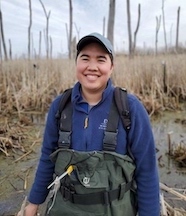

Abstract
Incorporating positive species interactions into ecosystem restoration is key to advancing conservation in a changing world. Identifying animals that can produce these impacts, then developing ways to harness these facilitation effects is critical to integrating this ecological theory into on the ground restoration and conservation efforts. Muskrats (Ondatra zibethicus) are a native Great Lakes ecosystem engineer that alter wetland systems by generating clearings in vegetation to build their dens. My preliminary data shows a 21-fold increase in animal use of areas around muskrat dens than control regions, suggesting a powerful positive species interaction where these clearings facilitate increased biodiversity, particularly of regionally declining marsh birds. Thus, I am proposing to develop and test a novel solution – harness the effects of muskrat ecosystem engineering by creating their dens through biomimicry. By mimicking their dens, I can test whether muskrat dens are a tool for increased biodiversity and enhanced ecosystem function, similar to ecosystem engineers in other systems. In this research, I will 1) create “mimic dens” and test how they impact wetland diversity and function relative to natural dens, 2) determine optimal densities of dens that would most benefit 11 species of regionally declining marsh birds for wildlife managers, and 3) work directly with local stakeholders to create a den mimicry implementation guide for conservation groups and restoration practitioners throughout the Great Lakes. Because mimicking dens could restore historic marsh bird diversity and improve wetland function by storing carbon, this research will serve as important tool and actionable example of how to harness positive species interactions within restoration efforts for improved biodiversity and resilience in a changing climate.
